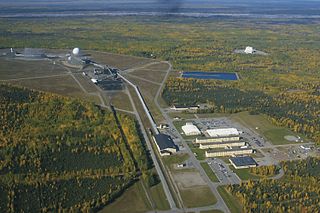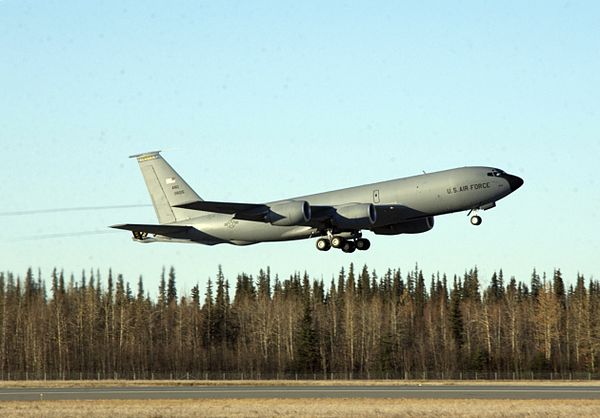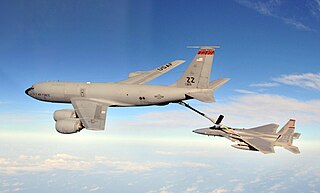
The Boeing KC-135 Stratotanker is a military aerial refueling aircraft. Both the KC-135 and the Boeing 707 airliner were developed from the Boeing 367-80 prototype. It is the predominant variant of the C-135 Stratolifter family of transport aircraft. The KC-135 was the US Air Force's first jet-powered refueling tanker and replaced the KC-97 Stratofreighter. The KC-135 was initially tasked with refueling strategic bombers, but was used extensively in the Vietnam War and later conflicts such as Operation Desert Storm to extend the range and endurance of US tactical fighters and bombers.

Beale Air Force Base (AFB) is a United States Air Force base located approximately 8 miles (13 km) east of Marysville, California.

McConnell Air Force Base is a United States Air Force base located four miles (6 km) southeast of the central business district of Wichita, a city in Sedgwick County, Kansas, United States. The airbase was named in honor of the brothers Fred and Thomas McConnell of Wichita, who had both been Air Force pilots and veterans of World War II. It is the home of Air Mobility Command's 22d Air Refueling Wing, Air Force Reserve Command's 931st Air Refueling Wing, and the Kansas Air National Guard's 184th Intelligence Wing.
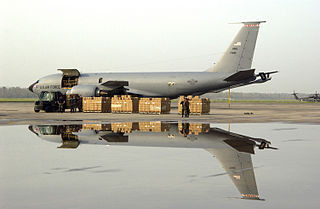
The 155th Air Refueling Wing is a unit of the Nebraska Air National Guard, stationed at Lincoln Air National Guard Base, Nebraska. If activated to federal service, the Wing is gained by the United States Air Force Air Mobility Command.

The 22d Air Refueling Wing is a United States Air Force unit assigned to the Air Mobility Command's Eighteenth Air Force. It is stationed at McConnell Air Force Base, Kansas and also functions as the host wing for McConnell.

The 940th Air Refueling Wing is part of the Air Reserve Component of the United States Air Force. It is assigned to the Tenth Air Force of the Air Force Reserve Command, is operationally-gained by the Air Mobility Command, and is home stationed at Beale Air Force Base, California.

The 101st Air Refueling Wing is a unit of the Maine Air National Guard, stationed at Bangor Air National Guard Base, Bangor, Maine. If activated to federal service with the United States Air Force, the 101 ARW is operationally-gained by the Air Mobility Command (AMC).

The 126th Air Refueling Wing is a unit of the Illinois Air National Guard, stationed at Scott Air Force Base, Belleville, Illinois. If activated to federal service, the Wing is gained by the United States Air Force Air Mobility Command.

The 128th Air Refueling Wing is a unit of the Wisconsin Air National Guard, stationed at General Mitchell Air National Guard Base, Milwaukee, Wisconsin. If activated to federal service in the United States Air Force, the wing is operationally gained by the Air Mobility Command (AMC).

The 141st Air Refueling Wing is a unit of the Washington Air National Guard, stationed at Fairchild Air Force Base, Spokane, Washington. If activated to federal service, the Wing is gained by the United States Air Force Air Mobility Command.

The 160th Air Refueling Group is an inactive unit of the Ohio Air National Guard. It was last stationed at Rickenbacker Air National Guard Base, Columbus, Ohio. The 160th ARW was inactivated on 1 October 1993.

The 171st Air Refueling Wing is a unit of the Pennsylvania Air National Guard, located at Pittsburgh International Airport in Coraopolis, Pennsylvania. If activated to federal service, the Wing is gained by the United States Air Force Air Mobility Command.
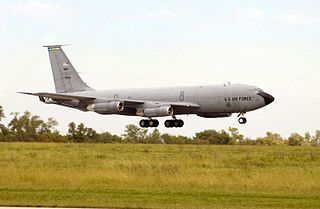
The 190th Air Refueling Wing is a unit of the Kansas Air National Guard, stationed at Forbes Field Air National Guard Base, Topeka, Kansas. If activated to federal service, the Wing is gained by the United States Air Force Air Mobility Command.

The 203d Air Refueling Squadron is a unit of the Hawaii Air National Guard 154th Wing located at Joint Base Pearl Harbor-Hickam, Honolulu, Hawaii. The 203d is equipped with the KC-135R Stratotanker.

The 168th Air Refueling Squadron is a unit of the Alaska Air National Guard 168th Air Refueling Wing located at Eielson Air Force Base, Fairbanks, Alaska. The 168th is equipped with the KC-135R Stratotanker.

The 145th Air Refueling Squadron is a unit of the Ohio Air National Guard 121st Air Refueling Wing located at Rickenbacker Air National Guard Base, Columbus, Ohio. The 145th is equipped with the KC-135R Stratotanker.

The 117th Air Refueling Squadron is a unit of the Kansas Air National Guard 190th Air Refueling Wing located at Forbes Field Air National Guard Base, Topeka, Kansas. The 117th is equipped with the KC-135R Stratotanker.

The 93d Air Refueling Squadron is part of the 92d Air Refueling Wing at Fairchild Air Force Base, Washington. It operates the Boeing KC-135 Stratotanker aircraft conducting air refueling missions.






